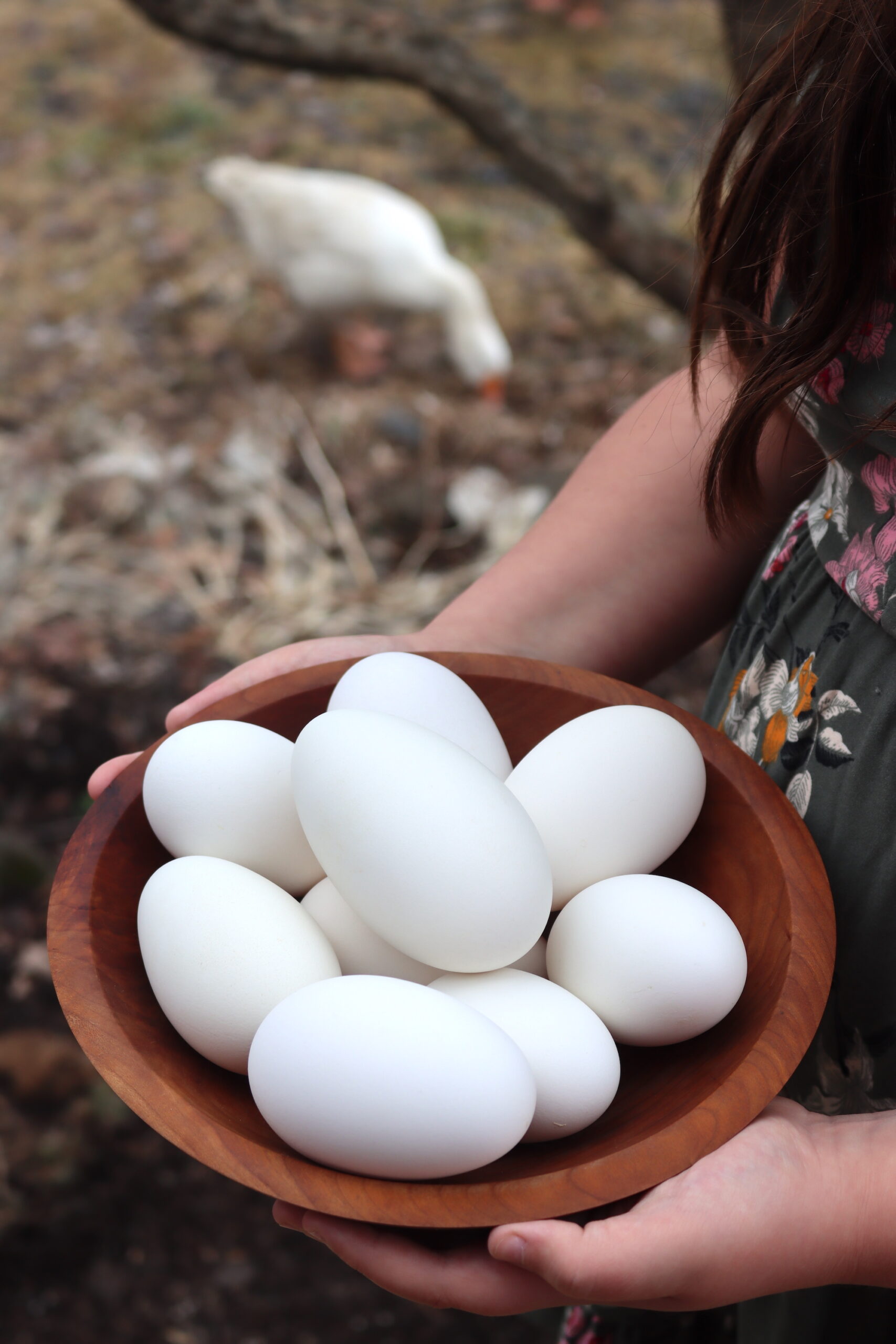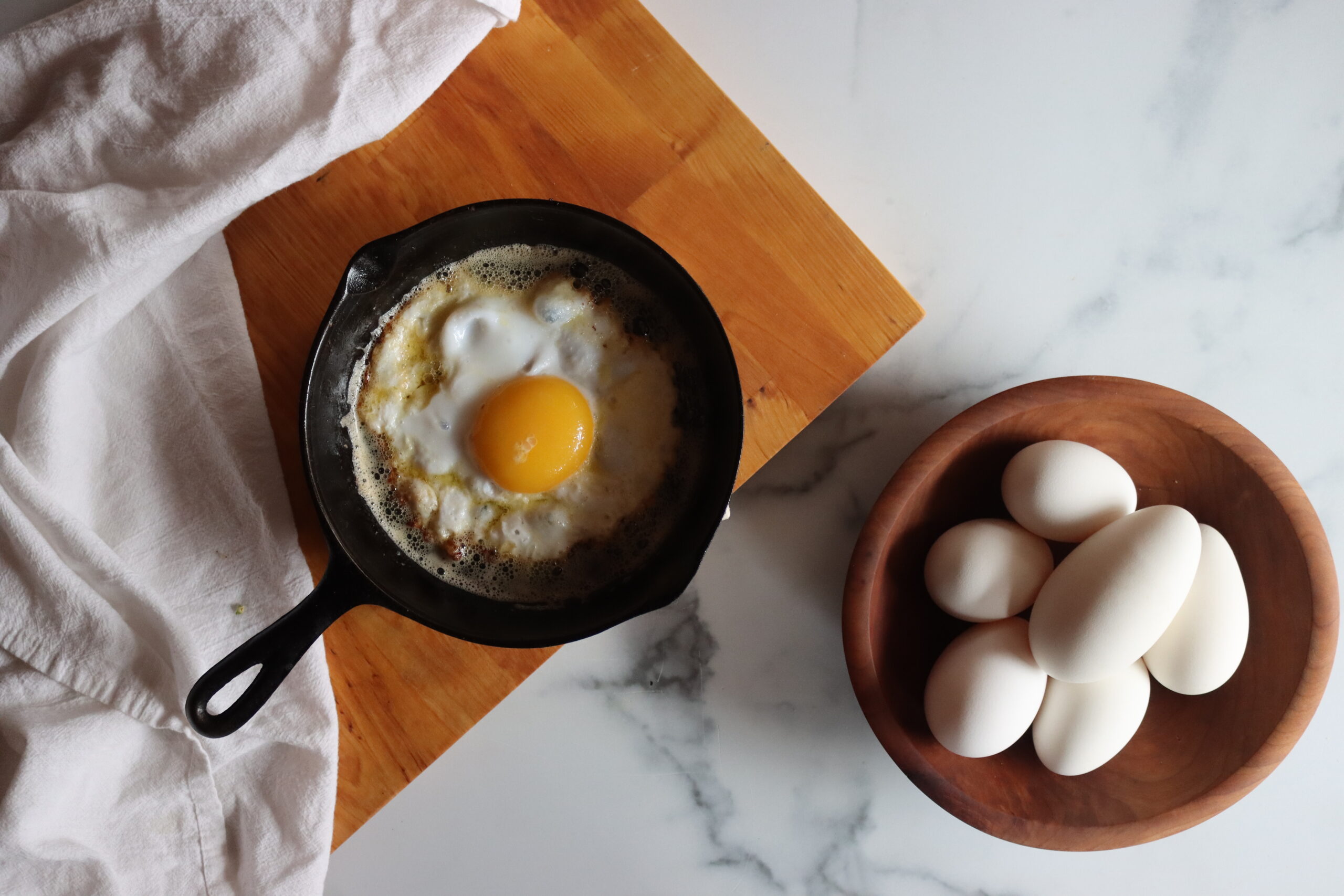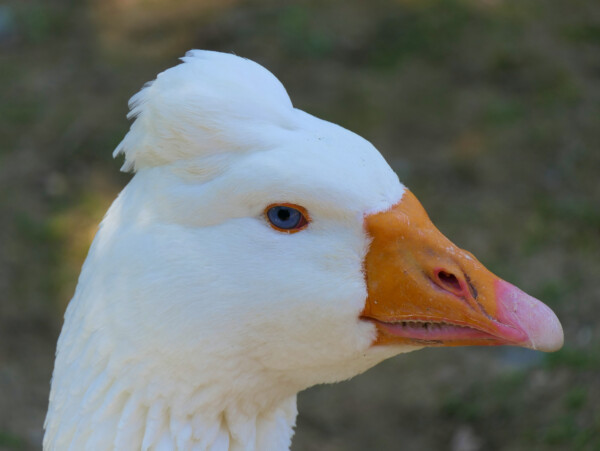Affiliate disclosure: This post may contain affiliate links. Please see our Privacy Policy.
Lovely, large and round, goose eggs are a robust egg and a delightful treat. Different from both duck and chicken eggs, goose eggs are richer with a more distinct flavor.

Table of Contents
Geese may not lay eggs as often as chickens, but what they lack in quantity, they make up for in size and flavor.
You may be tempted to think that the only difference between a chicken egg and a goose egg is its size, but how wrong you’d be!
Besides being two to four times the size of a standard chicken egg, goose eggs have a much thicker shell and a higher proportion of yolk to egg white. Their thicker shell makes them harder to crack, and the higher ratio of egg yolk renders them richer and more nutritionally dense than other eggs.
While chicken eggs have a general ratio of ⅓ yolk to ⅔ egg white, goose eggs have more of an even split, being closer to half yolk and half egg white. As a result, goose eggs are perfect for adding moisture and density to baked goods. Yet, you can’t just substitute them for chicken eggs due to this difference in makeup. Consequently, a nice collection of recipes tailored to these yolk-rich eggs is quite the commodity when in possession of a gaggle of goose eggs.

Choosing the Best Goose Eggs
If you’ve been gifted some goose eggs or been fortunate enough to source them from a market or farm, you are a lucky individual indeed. Goose eggs tend to be much pricier than other eggs due to their undersupply, as geese lay them in limited numbers. For this reason, some homesteaders choose to raise geese for the particular goal of egg-laying.
When raising geese for the purpose of eggs, some breeds are considered better than others. Some recommended geese for egg-laying include White Emden which can supply 35 to 45 eggs yearly, French Toulouse, which lays up to 50 eggs per year and White Chinese, which can lay up to 55 annually.
Once your geese start laying, the next, somewhat difficult step, will be finding those eggs.
You’d think given their size, goose eggs would be easy to stumble across – this is not always true! Although you may have provided a goose nest, geese will sometimes go off on their own to lay under bushes and shrubs or in tall grasses. Our geese actually bury their eggs in the coop bedding, so watch for that, too. After which, the hunt will be on.
Sometimes a goose that breaks off from the rest of the flock is about to lay, so keep an eye on any wandering solo geese when it’s egg-laying season.
Domestic geese tend to begin laying in the winter or early spring. The length of the laying season can hinge on many factors including age, diet, health, daylight and weather conditions. Geese are likely to lay their eggs early in the morning, laying an egg every other day on average.
If collecting your own goose eggs, wait until the goose has wandered away from the nest to collect the egg to avoid hissing and biting. Even well-trained, generally friendly geese will defend their eggs if you try to collect them while they’re in the neighborhood.

Goose Egg Recipes
Due to their foraged diet, goose eggs possess more flavor than chicken eggs. Correspondingly, they are darker colored as well as fattier, richer, and heavier in taste. Geese are foragers who hunt for their food in pastures; this varied diet leads to rich yolks and a much eggier-tasting egg.
Because of this, goose eggs are lovely for dishes requiring lots of rich egg yolk like custards, pasta and eggy breakfast dishes. Whipping goose egg whites for mousse and other stiff-peaked goods is not recommended however, as the egg white tends to be more watery than with chicken eggs or duck eggs. Some baking recipes may even call for the addition of a chicken egg white to balance out this mix.
For quick prep, goose eggs can be soft-boiled in 9 to 10 minutes and hard-boiled in 13 minutes. They’re lovely on their own, whether scrambled, fried, or poached. Know that cracking a goose egg can be a bit of a challenge the first time you attempt it. When new to cracking goose eggs, increase your force incrementally to avoid overcompensating and shattering your precious eggs.
Fresh Goose Egg Salad Recipes
What are some of the best uses for freshly collected goose eggs? Salads and tarts of course! Start off with a hard-boiled goose egg served atop a rich bed of greens, cherry tomatoes, prosciutto, pumpkin seeds and crumbled blue cheese for a delightfully filling salad. Another option is to top your salad with a soft-boiled or poached goose egg, allowing that creamy yolk to flavor ingredients as it spills.
Pair a poached goose egg with feta cheese, mixed greens and a dijon and bacon vinaigrette or try a French-inspired Nicoise salad with tuna, capers and sliced goose eggs.
- Goose Egg Salad with Blue Cheese and Prosciutto
- Poached Goose Egg served with a bacon balsamic salad
- Tuna Nicoise Salad with Goose Eggs
Goose Egg Breakfast Recipes
Due to their rich flavor and higher yolk content, goose eggs are spectacular when wielded in a number of breakfast dishes from scrambled eggs over toast to a grand omelet of arugula, mushrooms and fontina cheese. Add flavorful goose eggs to frittatas and quiches for larger gatherings or sample goose egg crepes for another wonderful morning meal, perfect for stuffing with either sweet or savory fillings.
For something new, be sure to try crispy goose egg fried, flipped and warmed in the oven, and finally plated with a creamed bacon and wild garlic sauce. A fried goose egg coated in a crust of breadcrumbs, capers, lemon, and herbs is another gourmet option, lovely for those brunch days when breakfast bleeds into lunch.
- Golden Goose Egg Omelet
- Scrambled Goose Eggs
- Frittata with Goose Egg
- Goose Egg Crepes
- Crispy Goose Egg with Creamed Bacon and Wild Garlic
- Fried Goose Egg with Caper & Lemon Crust
- Dutch Baby Oven Pancake (Replace 3 chicken eggs with 1-2 goose eggs)

Goose Egg Quiche, Tarts, and Savory Pies
A single goose egg is all you need to form the base of many savory tarts.
Try blending with simple spring asparagus and pesto or balancing with the flavors of turkey bacon, snow pea leaves, and sunchokes in a cauliflower crust tart. For an eggier spring tart, gather a few bundles of wild greens like nettles and dandelions.
Goose Egg Savory Main Courses
Eggs may not leap out as a prime ingredient in many dinner dishes, but robust and rich goose eggs can bridge the gap. Pair fried goose eggs with venison steak for a decadent and gamey main course or swap a goose egg for a regular hen egg alongside a coffee-rubbed goose steak embellished with chimichurri hollandaise.
Hearty goose eggs also lead to delicious pasta dishes. Make your own homemade pasta with only five ingredients (cold water, flour, salt, goose eggs and olive oil) and cascade with your favorite sauce. For more savory main course ideas, include goose eggs in carbonara, stir-fried pasta or simply top noodles with a soft-boiled goose egg.
- Venison Steak with Goose Egg and Chunky Chips
- Canada Goose Steak and Eggs with Chimichurri Hollandaise
- Homemade Pasta with Goose Eggs
- Goose Egg Carbonara
- Stir-Fried Pasta with Goose Eggs and Seasonal Vegetables
- Pasta with Soft Boiled Eggs
Goose Egg Soup and Sandwich Recipes
A good deal of Asian recipes make use of beloved goose eggs in soups and other rice dishes. For one such dish, consider goose egg congee – a soup-like rice porridge featuring nutrient-rich goose eggs. For more ideas, experiment with goose egg and mince meat in a marinated broth or test out eggy stracciatella soup with spinach, goose egg, parmesan, parsley and basil.
For a simple sandwich, incorporate a goose egg in your next BLT. Assembled from starchy Texas toast, havarti cheese, arugula and crispy bacon, a goose egg-topped BLT is a quick and tasty lunch. For more sandwich ideas, sample a goose egg in a classic egg salad sandwich or try out some Eiersalat, a German egg salad with apples and pickles.
Another egg salad recipe uses both goose fat and goose liver – subbing goose eggs for hen eggs seems like the next logical step. And for all those future sandwiches, contemplate whipping up some goose egg mayonnaise for a decadently creamy mayo. Spread it on buns and toasted breads or use it in chicken salad and tuna salad sandwiches.
- Goose Egg Rice Congee
- Goose Egg Minced Meat Soup
- Stracciatella Soup
- Goose Egg BLT
- Classic Egg Salad
- Goose Egg Mayonnaise
Goose Egg Snack Recipes
Grab some goose eggs for an assortment of tasty snacks. Due to their size, a few goose eggs can go a long way snack-wise, and their immense size can make an attention-grabbing appetizer. Consider deviled goose eggs cut into quarters, for instance. Goose eggs also make some enormously appetizing scotch eggs for satiating hungry mouths.
Other snackable nibbles born from goose eggs include simple goose eggs sliced and served with a cold dressing and chopped green onions, soft-cooked goose eggs served with polenta and greens, or perhaps a deviled egg dip for plating with crudite and crackers. Simply substitute one goose egg for every three hen eggs requested for a more flavorful result.
- Deviled Goose Eggs
- Goose Egg Scotch Eggs with Gluten Free Breadcrumbs
- Goose Eggs with Cold Dressing
- Soft Cooked Goose Egg
- Spicy Deviled Egg Dip
Goose Egg Dessert Recipes
Sample yolky goose eggs in a flock of desserts which make the most of these eggs’ rich qualities. The naturally larger yolks inherent in goose eggs lead to desserts that are rich, dense and moist. Goose egg custard is a lovely concoction made with only a few ingredients. Incorporate your goose egg custard in a goose egg custard pie or try your hand at goose egg lemon curd for more options.
Goose eggs also make fantastic cakes and quickbreads. Utilize goose eggs in recipes for pound cakes and sponge cakes, cupcakes or a chocolate cake enriched with the subtle notes of lavender. Densely rich and chocolatey brownies are another moist, fudgy treat. You may also use goose egg yolks to churn a richer ice cream by substituting one goose egg yolk for every three hen yolks requested.
- Naturally-Sweetened Goose Egg Custard.
- Berry Lemon Custard Pie
- Goose Egg Lemon Curd
- Goose Egg Sponge Cake
- Goose Egg French Sponge Cupcakes
- Lavender Chocolate Goose Egg Cake
- Chocolate Goose Egg Brownies
- Goose Egg Mint Ice Cream
Cultured & Fermented Goose Eggs
What’s the difference between fermented eggs and pickled eggs? Not a whole lot. Both fermentation and pickling are a form of preservation. The main difference is that while pickled eggs are typically preserved with vinegar or another acidic liquid, fermented eggs use bacteria or yeast to preserve and flavor eggs.
A good fermentation culture is all that is needed to produce some delicious fermented eggs for snacking or making egg salad. To culture or ferment eggs, you can simply pickle with salt and white wine, use a salt-brine and starter culture to ferment eggs or just dry-cure with salt. Another dry-curing method is to salt-cure just the egg yolk, as this is arguably the best part of a goose egg anyhow. These cured egg yolks are lovely for adding to everything from brunch benedicts to salads and pasta.
Preserving Goose Eggs
On occasion, the goose-laying season comes upon you suddenly and you’re finding eggs every other day. These mighty and rich eggs are lovely but can be a bit overwhelming in large numbers. Thankfully, there are several preservation methods to ensure your goose eggs can be enjoyed once the laying season has ended.
When goose eggs are in excess, there are two main methods of preservation: freezing and fermenting.
Goose eggs keep for around 3 weeks when refrigerated, after which they should be frozen. You can freeze goose eggs by cracking them, whisking them and storing the liquid inside freezer bags for use later in omelets or scrambles. Another freezing method involves using an ice cube tray along with some salt or sugar to protect the flavor of the egg and prevent freezer burn.
Like chicken eggs, it should be noted that currently freezing is the only recommended long-term storage for eggs by the FDA, although many other methods have been used throughout history. Some of these additional methods include pickling, salt-curing, waterglassing and even dehydrating.
Recipes tailored particularly to goose eggs are in short supply, so keep in mind many of the included preservation recipes are intended for chicken eggs and may need some adjusting for larger goose eggs.
- How to Freeze Eggs, Raw or Cooked
- Preserving Eggs in Limewater (Keeps 12+ Months)
- Freeze Drying Eggs at Home
- Dehydrating Eggs at Home




